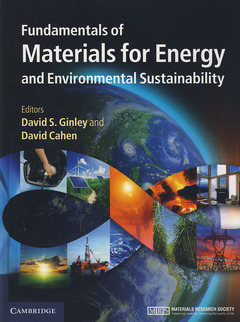Description
Fundamentals of Materials for Energy and Environmental Sustainability
Coordinators: Ginley David S., Cahen David
Understand the fundamental science behind the range of energy options currently open to us and their relationship to the environment.
Language: English
Subject for Fundamentals of Materials for Energy and Environmental...:
Publication date: 11-2011
772 p. · 22.3x28.7 cm · Hardback
772 p. · 22.3x28.7 cm · Hardback
Description
/li>Contents
/li>Biography
/li>
How will we meet rising energy demands? What are our options? Are there viable long-term solutions for the future? Learn the fundamental physical, chemical and materials science at the heart of renewable/non-renewable energy sources, future transportation systems, energy efficiency and energy storage. Whether you are a student taking an energy course or a newcomer to the field, this textbook will help you understand critical relationships between the environment, energy and sustainability. Leading experts provide comprehensive coverage of each topic, bringing together diverse subject matter by integrating theory with engaging insights. Each chapter includes helpful features to aid understanding, including a historical overview to provide context, suggested further reading and questions for discussion. Every subject is beautifully illustrated and brought to life with full color images and color-coded sections for easy browsing, making this a complete educational package. Fundamentals of Materials for Energy and Environmental Sustainability will enable today's scientists and educate future generations.
List of contributors; Preface; Acknowledgments; Part I. Energy and the Environment: The Global Landscape: 1. A primer on climate change; 2. The global energy landscape and energy security; 3. Sustainability and energy conversions; 4. Energy cost of materials: materials for thin-film photovoltaics as an example; 5. Economics of materials; 6. Global energy flows; 7. Global materials flows; 8. Carbon dioxide capture and sequestration; Part II. Nonrenewable Energy Sources: 9. Petroleum and natural gas; 10. Advancing coal conversion technologies: materials challenges; 11. Oil shale and tar sands; 12. Unconventional energy sources: gas hydrates; 13. Nuclear energy: current and future schemes; 14. Nuclear non-proliferation; 15. Nuclear-waste management and disposal; 16. Material requirements for controlled nuclear fusion; Part III. Renewable Energy Sources: 17. Solar energy overview; 18. Direct solar energy conversion with photovoltaic devices; 19. Future concepts for photovoltaic energy conversion; 20. Concentrating and multijunction photovoltaics; 21. Concentrating solar thermal power; 22. Solar-thermoelectrics: direct solar thermal energy conversion; 23. Off-grid solar in the developing world; 24. Principles of photosynthesis; 25. Biofuels and biomaterials from microbes; 26. Biofuels from cellulosic biomass via aqueous processing; 27. Artificial photosynthesis for solar energy conversion; 28. Engineering natural photosynthesis; 29. Geothermal and ocean energy; 30. Wind energy; Part IV. Transportation: 31. Transportation: motor vehicles; 32. Transportation: aviation; 33. Transportation: shipping; 34. Transportation: fully autonomous vehicles; Part V. Energy Efficiency: 35. Lighting; 36. Energy efficient buildings; 37. Insulation science; 38. Industrial energy efficiency: a case study; 39. Green processing: catalysis; 40. Materials availability and recycling; 41. Life-cycle assessment; Part VI. Energy Storage, High-Penetration Renewables and Grid Stabilization: 42. Toward the smart grid: the US as a case study; 43. Consequences of high-penetration renewables; 44. Electrochemical energy storage: batteries and capacitors; 45. Mechanical energy storage: pumped hydro, CAES, flywheels; 46. Fuel cells; 47. Solar fuels; 48. Solar thermal routes to fuel; 49. Photoelectrochemistry and hybrid solar conversion; Summary; Appendix A. Thermodynamics; Appendix B. Electrochemistry; Appendix C. Units; Index.
David S. Ginley is a Research Fellow and Group Manager in the Process Technology Group, National Center for Photovoltaics at the National Renewable Energy Laboratory (NREL). He received his BS in Mineral Engineering Chemistry from the Colorado School of Mines and his Ph.D. in Inorganic Chemistry from MIT. He is also Past President of the Materials Research Society (MRS). His principal areas of interest are in the application of organic/polymer materials, transition metal oxides and hybrid inorganic/organic semiconductor-based nanomaterials to energy conversion and energy efficiency in the areas of photovoltaics, batteries, fuel cells and OLEDs. He has over 400 publications and 30 patents.
David Cahen is a Professor at the Weizmann Institute of Science. He received his B.Sc. in Chemistry and Physics at the Hebrew University of Jerusalem (HUJI) and his Ph.D. in Materials Research and Physical Chemistry from Northwestern University. He then joined the Weizmann Institute in 1976, where he started work on solar cells. Today, his research focuses on alternative, especially solar, energy sources, aiming to understand electronic transport across (bio)molecules, exploring how molecules can control such transport and looking for novel science in such systems and for possible relevance to solar cells.
David Cahen is a Professor at the Weizmann Institute of Science. He received his B.Sc. in Chemistry and Physics at the Hebrew University of Jerusalem (HUJI) and his Ph.D. in Materials Research and Physical Chemistry from Northwestern University. He then joined the Weizmann Institute in 1976, where he started work on solar cells. Today, his research focuses on alternative, especially solar, energy sources, aiming to understand electronic transport across (bio)molecules, exploring how molecules can control such transport and looking for novel science in such systems and for possible relevance to solar cells.
© 2024 LAVOISIER S.A.S.

